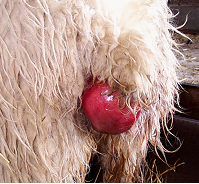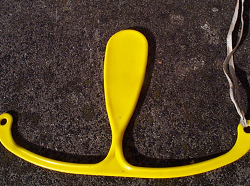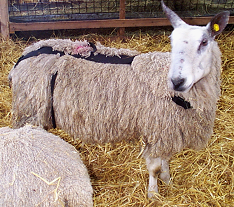Bearings/Vaginal Prolapses in Sheep
What is it?
A bearing/vaginal prolapse is when the vagina is pushed by the ewe to protrude externally.
To begin with it might look like a small amount of pink tissue that comes out beneath the tail when the sheep lies down, but gets sucked back in when she stands up. Later it will stop returning to its normal position and stay on the outside of the ewe all the time.
If it hasn’t been out for long it will look like a pink, moist, smooth mass at the rear end of the sheep. Once it starts to swell it will become darker in colour; it will start to become dry and rough, bruised and eventually the tissue will start to go black and die.
In the early stages you might see the sheep strain a lot, but in general they are bright. If the prolapse is left too long and the tissue starts to die (go dark red to black) then the ewe will often get very weak and sick.
When does it occur and why?
Vaginal prolapses tend to occur in the last month before lambing (occasionally they will occur after lambing).There is no single cause of vaginal prolapses, but there are a number of factors which increase the risk:
- Breed – more common in highly prolific breeds.
- Litter size – there is a 5 x increased risk in ewes with twins and an 11-12 x increased risk in those with triplets when compared with ewes only carrying a single lamb.
- Age- more common in older ewes.
- Prolapse history – 35-40% of ewes who have had vaginal prolapses, have them in subsequent pregnancies.
- Nutrition – high forage, access to salt and feeding swedes in late pregnancy can increase the number of prolapses in a flock.
- Lack of exercise – for example in housed ewes or when ewes are lame.
- Excessive body condition.
What can I do about it?
The earlier a bearing is identified and treated the better the outcome.
If the bearing is severely traumatized or black in colour, or the sheep is weak and sick it is better to shoot the sheep immediately, rather than prolong her suffering.
If the sheep is still bright and the bearing is still pink/red and warm either call the vet or replace it yourself as soon as possible:
- Restrain the ewe- have someone hold her still for you.
- Clean the prolapse with warm water with a small amount of betadine in it (colour of weak tea), remove all faeces and debris.
- Apply lubricant to the prolapse. With the flat of your clean hand or a closed fist gently push the prolapse back inside the ewe. Do not use individual fingers as you might traumatize the vagina. They will often urinate as you replace the prolapse. If the prolapse is very large it might contain the bladder also, so apply gentle pressure to enable the bladder to slowly empty and not rupture.
- Check that the cervix is not dilated with a lamb or water bag presenting.
- Once back inside use a bearing retainer to keep the prolapse in: put the central plastic tongue inside the vagina and keep it in using string to tie the 2 outer sections to the wool Alternatively a bearing harness/truss can be used (I prefer these to retainers as there is less risk of infection or recurrence of the prolapse when they are used correctly).
- Give the ewe a dose of long acting antibiotics such as Duplocillin and an anti- inflammatory injection e.g. Metacam or Flunixin.
- Mark the ewe/record her number, so that she is not bred from again.
- Check the retainer or harness daily to make sure it is not displaced or causing sores, and monitor the ewe more frequently when she is close to lambing so that the retention device can be removed and the lamb delivered.
Ewes will often continue to strain and might push the vagina back out again despite the retainer being used.In this instance it is best to call the vet as we can give her an epidural to stop her straining and suture the vulva closed to prevent further prolapse and trauma to the vagina.


(Photos courtesy of: http://www.nadis.org.uk/bulletins/lambing/lambing-part-3-vaginal-and-uterine-prolapse.aspx)

